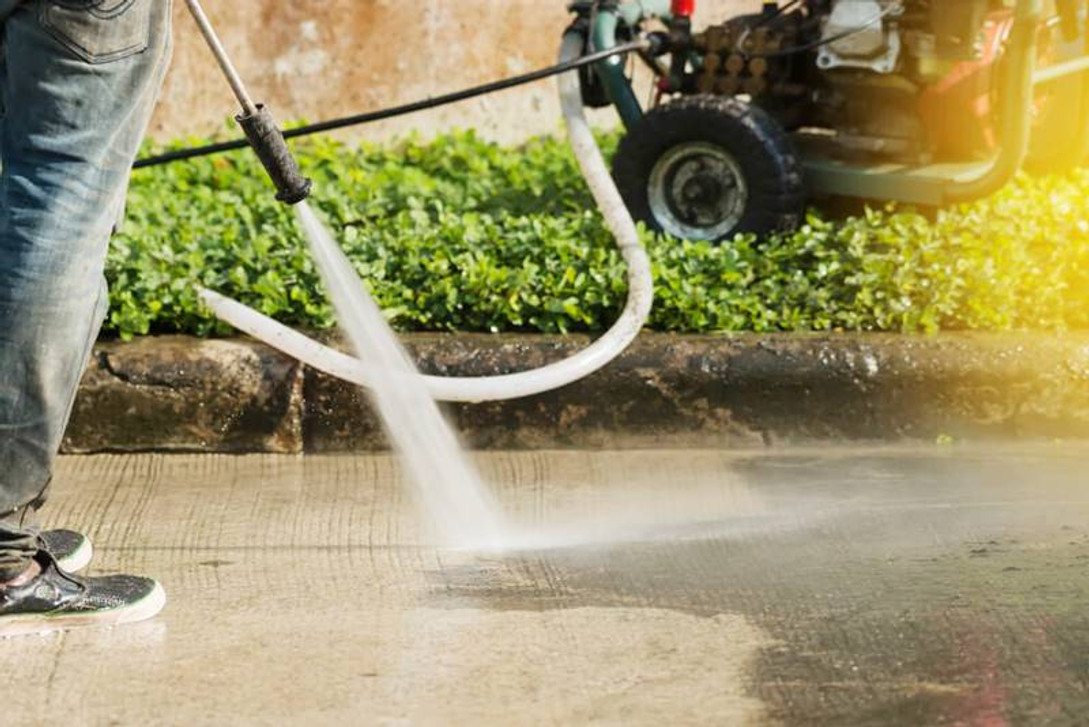Spring cleaning means exterior as well as interior. Now is the time to be cleaning up broken branches, cleaning out flower beds, getting your lawnmower ready for the year, and pressure washing you concrete. It is important to wash your garage, driveway, and walkways to remove road salts and chemical deicers that have accumulated over the winter. To most people, this means power (or pressure ) washing.
When we first started our business we received call from a lady who told us that someone had put graffiti on her driveway and asked us to remove it. She said it looked like symbols much like a snake. The funny thing was that the graffiti only appeared when the driveway was wet. We went to look at the driveway and discovered that someone had pressure washed the driveway using too much pressure and too direct of a tip and etched designs in the driveway. Etching is slightly blasting tiny bits of concrete off, engraving lines in the concrete which show up especially when the concrete is wet.
People frequently do not realize that you can actually damage your concrete driveway, patio, or other concrete areas by pressure washing. Most people believe that concrete is solid and almost invincible. However, using a pressure washer with the incorrect tip or using too much pressure or a combination of the two can etch concrete. Here are a few tips to allow you to safely pressure wash your driveway or any other concrete surface. Actually these work for just about any surface you choose to pressure wash.
1) Use the green tip when washing concrete. The red and yellow tips put all the pressure in a very small area and will blast the top off the concrete. The white and the black are more spread out and designed for washing cars, siding, etc.
2) Use a pressure washer between 3,000 and 3,500 PSI as nothing more powerful is needed for household maintenance. Small electric pressure washers are usually not a good option for the homeowner (other than being inexpensive) as they do not have enough PSI to really do the job of cleaning.
3) Many people see lines of dirt left after pressure washing, especially in areas near the end. These are usually caused by human error - you get tired and don't take as much time as when you started. An inexpensive answer to this is to use a turbo nozzle which rotates the water, cleans a bigger area, cleans well and does not leave lines.
4) If there is a lot of dirt, mold and mildew, or other stains,use a cleaner - let the detergent do the work - not you. Cleaners pull the dirt out of the open pores and give you a better clean. They also leave the pores open so you can get a good seal if you use a concrete sealer after cleaning. A pressure washer removes surface dirt but can't get inside the pores. Usually an all-purpose cleaner such as SealGreen Driveway and Garage Cleaner will handle the job.
5) Mold and mildew, rust and oil stains need special treatment and special cleaners. Rust is a chemical stain. Oil penetrates into the pores of the concrete and is difficult to remove. Pressure washing will remove the surface oil allowing the oil inside to resurface and the stain to return. Mold and mildew need to be cleaned as they are actually growing and spreading. It is best to use specialized cleaners such as Rust Remover, SealGreen Oil Cleaner/ Degreaser, Gray-Out Waterless Oil Cleaner, or SealGreen Mold and Mildew Cleaner.
6) Don't try to remove sealers or coatings with a pressure washer. Often times this leads to over-concentration of water pressure in small areas which blast the top off the concrete and leave etch marks. The majority of the strength of your concrete is in the top layer. Once this layer has been removed, your concrete is very susceptible to deterioration and damage.
7) Consider sealing your concrete in order to keep dirt and stains from penetrating into your concrete's open pores. This will keep your concrete cleaner longer and make it easier to clean when you do pressure wash it. The dirt and stains will stay on the surface, making them easier to remove. It also makes it easier to remove ice and snow in the winter time.
8) How to clean your concrete video. Happy Spring Cleaning from SealGreen. Please contact us if you have any specific cleaning issues.

